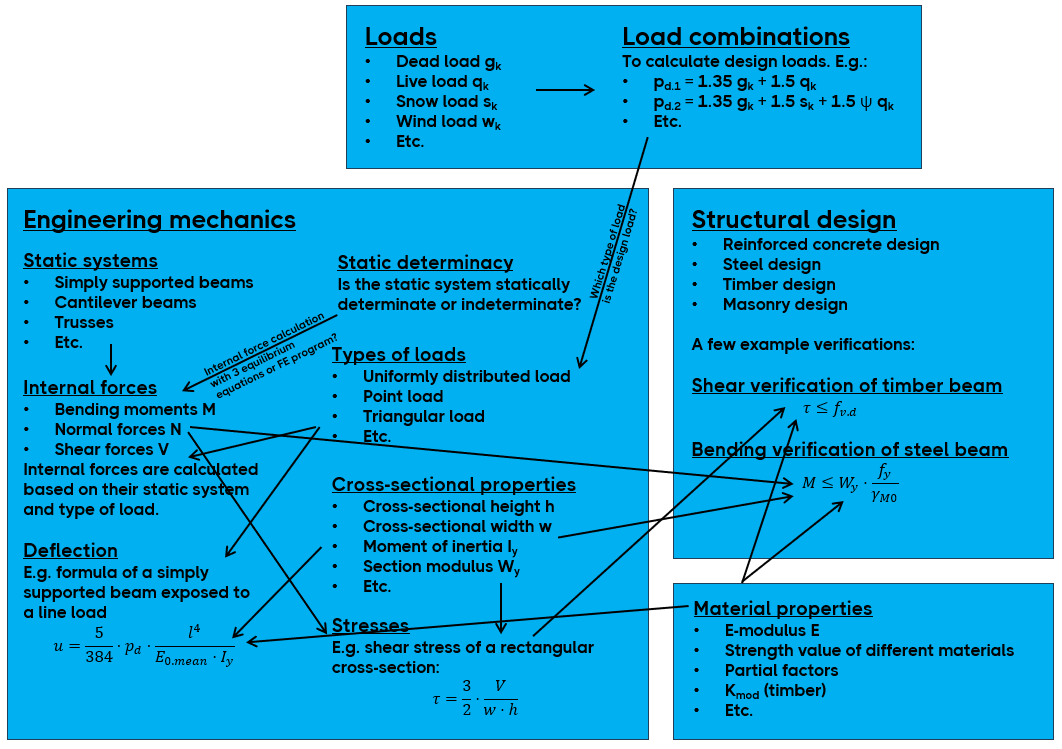Happy Wednesday, 🌞🌞
Today, we’re kicking off the biggest series yet - the reinforced concrete series. The next weeks and months will be packed with structural engineering value.
For this knowledge, people pay hundreds of dollars for to learn in university classes and seminars. But it’s going to be completely free for you in this newsletter.
Those of you who have been around for some time understand now how we structured the content of the last months. We have built up our knowledge of structural engineering fundamentals to be able to dive into structural design now.
We started on January 24th with the Engineering Mechanics Series. In these 16 weeks, we covered everything from static systems like simply supported beams, cantilevers, frames, etc. to the calculation of geometric properties like section modulus and moment of inertia of cracked concrete sections. Back then, 1215 people were subscribed to the Structural Basics newsletter. Today, we are over, 7500+ structural engineers in this community.
On June 12th we continued with the Structural Loads Series. 4048 of you had already been part of the team there. Week by week, we learned how to calculate the characteristic loads we use to design buildings and structures. In the end, we also learned how loads travel through a building.
These 2 series were necessary to have the necessary foundation to build a strong and stable building.
In my opinion, structural engineering verifications can be split up into 3 or 4 parts:
Loads and load combinations
Engineering mechanics
Material properties
Structural design
Without knowing how to calculate loads or which static system to use, you can’t design a reinforced concrete beam correctly.
Introduction To What’s Coming
There will be so much content, guys. I did a quick brainstorming session a few weeks back, writing down article topics, and the list is huge. I hope you are ready for it.
Occasionally, we’ll be publishing content about other topics, as we have been doing. This could be a guest post, a personal story from our industry, an article about a cool tool or workflow I use.
So here are a few topics we’ll be covering in this new series:
Concrete and reinforcement properties
Bending verification of rc beams and slabs
Shear verification of rc beams and slabs without shear reinforcement
Shear verification of rc beams and slabs with shear reinforcement
Compression verification
Calculation of the creep coefficient
Crack verification of rc beams and slabs
Deflection analysis
Torsion verification
Anchorage and lap lengths of reinforcement
The strut and tie method to design pile caps, corbels, moment stiff corners, etc.
Once we have covered these verifications/”basics”, we’ll move on to design “real” structural elements.
Design and verification of:
Rc beams
Rc slabs
Rc pad and strip footings
Rc frames
Rc walls
Rc pile caps
These were a few article topics from my list.
And as we go, I’ll find new topics, which we’ll write about.
Final Words
I am really excited about this new series, because structural design is the thing I enjoy the most about structural engineering.
And seeing your design come to life is really rewarding. Our designs have an impact on other people’s life and our environment.
If you want to catch up on engineering basics (which will definitely help you for the reinforced concrete series), I’ll recommend checking out our video tutorial on the different types of beams, we use in structural engineering.
Short intro today, I’ll see you next Wednesday.
Cheers, 👋👋
Laurin.
Enjoy the newsletter? Please forward to a friend you think could like our structural engineering content. It only takes 14 seconds. Making this one took a few hours. Just forward this link: https://www.structuralbasics.com/newsletter/






Thanks much.
I look forward to doing this course with you. Your work so far has indeed been a blessing. Much appreciated.
Brilliant Laurin, great work as always!
There are many interesting discussions to be had around capacity based checks and how different governing bodies deal with them. The Eurocode approach is very different to what we use in Canada and the US in a few areas but mainly in their underlying design philosophies, levels of conservatism, and approaches to incorporating probabilistic analysis.
I appreciate how Eurocodes emphasize Performance-Based Design, it's more adaptable and easier to find efficiencies on different projects but it does lead to more subjectivity, for better or worse.
Looking forward to the reinforced concrete series!!